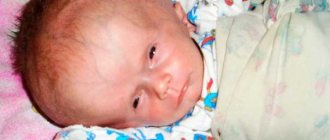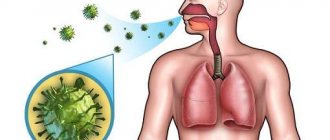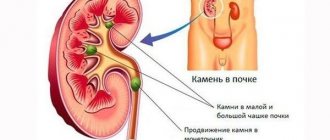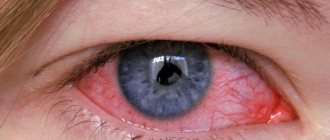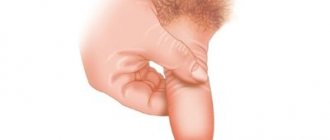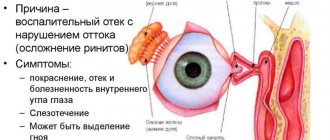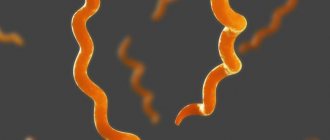Hydrocele of the testicles in boys
Dropsy on the testicles in boys most often appears immediately after birth. It can be detected even during uterine development and medicine knows cases where the pathology was known already at 31 weeks of pregnancy. A hydrocele is characterized by the accumulation of fluid in the scrotum, which should not occur normally in the body. The formation of dropsy leads to its gradual increase, which creates a lot of complications. But if the disease manifests itself in infants, it can go away on its own without special treatment.
Hydrocele in the testicles of a newborn
Basically, already in the seventh month of development, the testicles descend into the scrotum. During this period, when they move into place, a thin film of connective tissue located in the peritoneum can be captured and lowered. This piece of tissue lines the cavity inside the baby's abdomen. All this leads to the formation of a pocket, which normally should close before the baby is born. Sometimes it happens that it still remains several months after birth, but then goes away on its own.
This mechanism is not affected by infection or injury, as is the case in adults. Based on this, despite the presence of the same symptoms, this disease belongs to a slightly different category, since in most cases it goes away on its own as the body develops. Hydrocele of the testicles in newborn boys disappears during the first year, and more often even in the first months.
Naturally, this does not go away without a trace for everyone, and sometimes all the symptoms remain even after two years. This phenomenon does not create a big problem for the development of the genital organs at this age, so there is still time to take the necessary procedures for treatment.
Hydrocele in boys: types of hydrocele
There are two main types of hydrocele, which can be present in both children and adults. It could be:
- Communicating hydrocele of the child's testicle;
- Isolated hydrocele of a child
If a boy develops a communicating disease, then the peritoneal fluid, which passes along the processus vaginalis and enters the created pocket, begins to accumulate in the scrotum, but can also flow into the peritoneum. The presence of a lumen in the process creates a phenomenon that in some positions the dropsy can be very visible, and in others it can disappear without a trace. As long as there is a gap, the liquid will flow uncontrollably from one place to another. By 1-1.5 years, the hole is overgrown and the excess fluid that has accumulated in the scrotum is absorbed. If such a pathology is noticed, then it should not be left to chance. You need to undergo periodic examinations with a doctor to know how the disease progresses.
Considering what hydrocele of the testicles looks like in newborns with an isolated type of pathology, it is necessary to note the constancy of its presence in the scrotum, since the fluid does not disappear anywhere along the lumen. In this case, the fluid that accumulates in the scrotum is produced by the vaginal lining. This is a natural process necessary to provide lubrication as the testicles move within the scrotum. But if there is a deviation in the form of an imbalance of absorption and production, then this leads to excessive accumulation.
How to treat hydrocele in a newborn
Treatment of all diseases in infants requires special delicacy. Taking into account the fact that physiological hydrocele of the testicles in newborns has the above-mentioned features of formation, it has not been treated for a long time. This is quite justified by the underdevelopment of some body systems, which can return to normal in the first years of life. The main thing is not to interfere with them at first, since the physiological manifestations of hydrocele are quite easy to observe. The main thing for parents during this period is to prevent digestive disorders and the appearance of colds. Stomach upsets and coughing cause increased intra-abdominal pressure. This can increase the flow of fluid into the scrotum, complicating the hydrocele.
If dropsy does not go away several years after birth, then surgical treatment is required. It cannot be carried out if the child is under two years old. When a hydrocele remains for such a long period, the likelihood that it will go away on its own becomes much less likely. In the future, it will interfere with the development of the reproductive system, therefore, the sooner you can get rid of the disease, the better. Children tolerate operations quite well. For them, general anesthesia is mandatory.
Hydrocele of the testicles in a 3 year old child
When at the birth of a boy there were no signs of dropsy, and then it appeared, then it already has an acquired character. This is a more serious pathology, since you should not hope that everything will go away on its own. Childhood trauma is not very uncommon and it is because of it that hydrocele most often forms in little boys. Any injury to the testicles and groin area can cause excess fluid to accumulate in the scrotum. This is a progressive disease, the treatment of which should not be delayed for a long time.
For the acquired form of dropsy, even in childhood, surgery must be performed. Thanks to fairly frequent examinations during medical examinations at kindergartens and schools, such diseases can be detected in a timely manner before they cause serious consequences. The sooner treatment is carried out, the easier the operation will be and the less chance there is of relapse and complications.
Having figured out what dropsy is in a boy, the parent should not panic too much. This is a common pathology for which there are many treatment methods. Regardless of the form of the disease, doctors will always be able to help solve the problem with high efficiency. Complications in children occur much less frequently than in adults, since treatment is not always achieved. Operations for treatment are carried out in almost all city clinics with the presence of a pediatric urology surgeon.
Causes
Depending on the cause of occurrence, there are 2 types of congenital hydrocele in children - communicating and non-communicating.
- A communicating hydrocele of the testicle is formed during its descent into the inguinal canal. The vaginal process of the peritoneum moves along with it. The hole between the testicle and the peritoneum should be completely closed. If this does not happen, the fluid secreted by the peritoneum accumulates in the testicular area.
- Non-communicating hydrocele of the testicular membranes is characterized by complete closure of the opening between the peritoneum and the testicle. Fluid accumulates due to the production of exudate by the processus vaginalis.
Important! The amount of exudate formed does not depend on the cause of the disease. Both types can be insignificant or abundant, reaching up to several liters.
Normally, the gap between the peritoneum and the testicle does not heal for up to 1.5-2 years. Before reaching this age, therapy is not carried out. Spontaneous healing of the hole and resorption of the exudate are possible.
In addition to congenital hydrocele, there may be the formation of an acquired hydrocele in a child. The following conditions are the causes:
- groin injuries;
- malignant and benign formations;
- inflammatory processes of acute and chronic course;
- violation of lymph outflow.
Due to the above factors, excess liquid is formed, which is not absorbed (not excreted). Parents should know why a secondary hydrocele can form for what reasons in order to prevent it.
Hydrocele of the testicle in a child: causes of occurrence
Nothing occurs in the body without any reason. Even if these are congenital factors, something still influences them. The range of options for why hydrocele can form in children is much higher than in adults, since even the course of the disease occurs somewhat differently here. The causes of hydrocele in a child can be different and all of them can be divided into two main groups: acquired and congenital.
Hydrocele of the testicle in an infant: congenital causes
When it comes to newborns, hydrocele becomes a relatively minor pathology that has virtually no effect on the boy’s health. Moreover, even if it is detected in the womb, which can be seen during an ultrasound examination, it is not shown in the conclusion, since it does not become a threat to life and does not require treatment. This is not due to gene mutation. Most often it manifests itself in the form of communicating dropsy, since one of the main causes here is an embryonic disorder in the form of a growing vaginal process.
The causes of hydrocele in children are:
- Birth trauma, which is characterized by the appearance of a hydrocele after childbirth, so that it could not be seen on ultrasound beforehand;
- Prematurity, due to which some organs and systems of the baby did not have time to develop, since in a normal state they would have reached the required stage in the womb;
- Difficulties during pregnancy and the pathological course of pregnancy during which the mother was exposed to chronic and infectious diseases, infections, there were threats of miscarriage and other negative phenomena;
- The testicle does not descend into the scrotum (cryptorchidism);
- Abnormal development of the genital organs, in which the urethra opens at the shaft of the penis rather than at the head (hypospadias).
It is also possible to identify a number of pathological processes that lead to an increase in abdominal pressure, which leads to various pathologies of the scrotum. Such pathologies that contribute to the development of hydrocele in newborns, the causes and treatment of which are determined by a doctor, may include the following:
- The appearance of ascites, which manifests itself as an accumulation of fluid in the peritoneum, from where it can move into the scrotum;
- Peritoneal dialysis;
- The presence of ventriculoperitoneal shunts, which are installed in the abdominal cavity to drain excess fluid;
- Defects in the abdominal cavity.
Acquired hydrocele in newborns: causes and treatment
The acquired form is caused by external causes that were absent at birth. They can appear either at a very early age, in the first year of life, or later. The main reasons include the following:
- Physical torsion of the testicle, which leads to injury and the development of various pathologies, including hydrocele;
- Injuries that affect the scrotum itself and the area next to it, which can also provoke the development of various diseases;
- Tumor of the appendages and testicles, which can begin even at an early age and lead to such complications;
- Vascular and heart failure in an infant, which sometimes manifests itself in severe form;
- The appearance of infectious diseases, especially when they develop into a severe form (this includes mumps, influenza, ARVI and others);
- Inflammation of the testicle and various diseases that cause such a factor (epididymitis, orchitis and others);
- The appearance in the body of parasitic worms that infect the lymphatic systems during their life in the host’s body and cause filariasis;
- The occurrence of complications after operations.
When hydrocele occurs in a child after surgery, the causes and treatment become extremely clear. As a rule, acquired forms require immediate surgery, while the congenital form most often goes away on its own.
Hydrocele in a child: causes and consequences
If the disease becomes protracted, then it is no longer so important what exactly caused it, because with prolonged absence of treatment, the consequences become a big problem. In fact, the development of the disease in children manifests itself very quickly and is easier to detect than in adults, so long-term latent forms of hydrocele are not observed.
Negative consequences include painful sensations that will torment the child when walking and other physical activity. Considering the causes of hydrocele in a baby and photos, you can often encounter such a phenomenon as inflammation. It can become not only the cause, but also the consequence of the disease when it manifests itself on the scrotum.
Further problems in the development of the genital organs also become a serious consequence. The boy’s reproductive system has not yet had time to form, and he is already affected by various negative factors that depress the not yet developed testicles and contribute to the appearance of foreign objects inside the scrotum. This can lead to a lot of negative developmental consequences, so treatment must be done in a timely manner.
For dropsy in boys, the causes and treatment should be a matter for doctors to investigate. Parents are required to promptly contact and monitor all changes in the child’s health that may occur.
Complications from testicular hydrocele
Ignoring treatment for hydrocele can lead to the following consequences:
- compression of the testicle;
— testicular atrophy with subsequent development of infertility;
— violation of potency, ejaculation;
- psychological discomfort.
Timely treatment of testicular hydrocele in most cases leads to complete disappearance of symptoms and a favorable outcome. However, significant and prolonged accumulation of fluid in the membranes of the testicle with constant compression in young people can lead to testicular shrinkage and impaired spermatogenesis.
Signs of hydrocele in a child
Despite the fact that hydrocele may have different causes of formation in childhood and adulthood, the manifestations of the disease are largely similar.
Signs of hydrocele in a child are as follows:
- Painful sensations in the scrotum;
- Swelling of the testicles, which may appear on one or both sides;
- A round formation near the testicle, protruding and deforming the appearance of the scrotum;
- Change in skin color and increased tension.
For almost all signs, doctors prescribe an ultrasound scan, since they may be similar to the manifestations of other diseases.
Therapy
Treatment depends on the reasons that caused the condition. Drug therapy is carried out if dropsy has formed under the influence of another disease, for example, an inflammatory process (epididymitis). The surgical method is used when dropsy develops as an independent disease.
Medication
Treatment of hydrocele in children without surgery is carried out if the cause is trauma, inflammation of organs, torsion of the testicle, hydatid (brush-shaped formations on the testicle). It is not the accumulation of serous exudate itself that is treated, but the primary cause of the disease.
- Antibacterial therapy is used when there is a proven infectious cause of the process. Broad spectrum agents are used. If there is no effectiveness, then a puncture is prescribed. A study is carried out to determine the bacteria and its sensitivity to antibiotics. Antibacterial therapy is carried out to prevent the development of purulent complications. If the therapy works, the fluid resolves on its own without surgery.
- Anti-inflammatory therapy will help relieve swelling by eliminating the release of immune cells and fluid from the vessels. As swelling decreases, pain also decreases.
- Painkillers are rarely used in children. Their use is possible for no more than 7 days. With hydrocele of the testicles, pain occurs only when the process worsens or complications arise.
Evacuation of fluid using puncture
The method is applicable if minor testicular hydrocele develops in a 3-year-old child. Until this time, doctors do not advise carrying out the procedure. By inserting a needle into the scrotum, excess fluid is pumped out. After complete elimination of the exudate, sclerosing drugs are administered.
The intervention is not radical and is performed under general or local anesthesia. The method's morbidity is reduced. The negative side is the frequent occurrence of relapses of the disease. Therefore, doctors rarely prescribe a puncture treatment method. Indications for its implementation are the parents’ refusal to undergo surgery or the patient’s serious condition.
Symptoms of hydrocele in a child
Hydrocele is most often discovered at those moments when parents carry out various hygiene procedures, if we are talking about an acquired disease. In older boys, this may be detected during a routine examination, and in newborns with a congenital form, this is determined even before birth.
Hydrocele of the testicle: symptoms in children, regardless of age, remain the same.
Symptoms of hydrocele in a child
Most often, parents or doctors notice an increase in the size of the scrotum, which leads to suspicion of hydrocele. But this is far from the only way the disease manifests itself. With hydrocele, the symptoms in a child may be as follows:
- The appearance of chills;
- Periodic vomiting and nausea;
- Restlessness and crying of the child when touching the scrotum (sometimes he himself, instinctively covering the sore spot, holds on to it);
- General malaise that hardly goes away;
- Increase in temperature;
- The skin near the formation of dropsy turns red;
- Bursting sensations in the groin area, which typically manifests itself with the sudden development of the acute form of the disease;
- Problems with urination (most often urinary retention).
Along with an increase in size and deformation of the scrotum, cyanosis of the skin often occurs. At the same time, swelling in nearby areas becomes visible. This may indicate injury and other unpleasant manifestations. Whatever symptoms appear, it is very important to take a timely decision to consult a doctor.
With some symptoms, the disease develops much faster than with others. Many of them manifest themselves in complex ways. The more symptoms are collected during an individual manifestation, the more complex the case. One of the difficulties in detecting symptoms in children is that the older they grow, the less contact they have with their parents, and even when problems clearly arise, they are embarrassed to talk about them.
With hydrocele, the symptoms in newborns are immediately visible, since there is no secrecy here. In the future, they can be detected during preventive medical examinations. For safety reasons, parents should periodically examine their child themselves or take him to see a doctor. After the first symptoms are detected, a more detailed diagnosis of the disease follows using various means. Only after tests can a final diagnosis be made.
Description of the disease
Inside the scrotum are the testicles, which are covered with the tunica vaginalis. It is she who produces serous fluid, which gradually accumulates and leads to hydrocele. In this case, visually the scrotum becomes slightly or sharply enlarged, and urination is sometimes difficult. Children are characterized by a congenital form of the disease, which begins to manifest itself between birth and one year.
Based on the area of distribution, hydrocele is divided into two forms:
- unilateral (dropsy of the left or right testicle);
- bilateral (exudate is formed in both testicles).
With abundant accumulation of fluid, a complication is possible in the form of the development of another pathological process - an inguinal hernia. This is a process in which the internal organs of the abdominal cavity move beyond their normal location.
Parents of boys need to know what a hydrocele is, how it forms and looks. It is important to consult a doctor in time to eliminate the cause and prevent consequences for the child’s body.
Hydrocele of the testicles in boys: treatment
The method of treating the disease largely depends on what exactly caused it. With physiological hydrocele in a child, treatment is not required, since this form is quite easy to observe at this age. Up to a year, all symptoms and manifestations of hydrocele can go away without any external intervention
Hydrocele of the testicles in boys: treatment of the acquired form
If hydrocele manifests itself in an acquired form, then you first need to cure what led to its appearance. For children, there may even be drug treatment, but it does not always give the desired effect:
- If a hydrocele appears from an injury, then anti-inflammatory non-steroidal drugs prescribed by a doctor should be used to relieve pain and swelling;
- If it was infectious testicular hydrocele in an infant, treatment involves the use of non-steroidal antiviral antibiotics
Hydrocele of the testicles in boys: surgery
If over time, after a year from birth, the congenital form does not go away on its own, or the drug treatment method turns out to be ineffective, then, as in adults, surgery has to be used. Surgical intervention is much more effective and gives a highly effective result, but for the child it may seem too dangerous, so they try to postpone this moment. It is not recommended to operate on children under two years of age. If surgery is necessary, general anesthesia is used.
If the child is over 12 years old, then the same operations are used for him as for adults:
- Bergman's technique;
- Lord's technique;
- Ross Method;
- Winkelmann technique.
When performing them, you need to make an incision to get to the problem area and pump out the accumulated fluid. After this, the shells are stitched in different ways, which depends on the chosen technique.
For testicular hydrocele, treatment in children using the Winkelmann method involves inverting the membrane of the hydrocele and suturing it. Thanks to this, all surrounding tissues will absorb the emerging fluid. Upon completion of the operation, the wound is sutured in layers.
Bergmann's operation is used when the child's disease progresses sharply and the hydrocele becomes large. As a rule, this is due to the presence of thick shells in this form. After concealment, the vaginal process is simply excised. It is stitched at the base, after which the doctor sutures the wound.
The operation using Lord's method turns out to be the least traumatic. Its main feature is that during it the testicle is not removed into the wound. This reduces the risk of injury to surrounding tissues. The vaginal membrane is only sutured and crimped.
For testicular hydrocele in newborns, treatment using the Ross method involves careful ligation of the processus vaginalis. The ligation is done in the area of the inguinal inner ring, after which it is cut off. Almost all operations require the creation of drainage before suturing the wound. This is a necessary condition that creates temporary restrictions on physical activity. In adults, this is only a month, and since children have higher regeneration, this period can pass noticeably more quickly. However, it is more difficult to keep track of children and ensure that they do everything.
It is worth performing surgery to remove a hydrocele due to injury only six months after receiving this injury. During this entire period, one can only observe the development of the disease. In some cases, in the first months the dropsy decreases in size.
Hydrocele of the testicles in boys: photos, treatment and indications for surgery
They try not to perform surgery until the child is two years old, but there are a number of reasons that cause complications and because of them it is necessary to perform surgery even before the child turns two years old. These reasons include:
- The presence of infection in the hydrocele, which can lead to serious complications;
- An unbearable feeling of discomfort in the groin area that haunts the child;
- The appearance of an inguinal hernia, which creates a high risk of strangulation;
- An abnormally rapid increase in size of the scrotum, which can provoke a number of serious complications.
For hydrocele of the testicles in newborn boys, treatment and photos rarely require mandatory surgery. This happens much less frequently than a simple congenital hydrocele, which goes away without any problems.
Sometimes, if an operation is required, but it cannot be performed at a specific period of time, although you should also not leave opportunities for the development of the disease, then a puncture should be used. It is done as simply as possible, but gives only a temporary effect. This will help buy time without creating a serious surgical impact that could harm your health.
Symptoms of the disease
The disease develops in acute and chronic forms. Each of them is characterized by separate symptoms. In an acute process, the following signs are formed:
- increased volume of the scrotum;
- pain at rest and when urinating;
- urination disorder;
- redness of the skin in the scrotum area.
The chronic form occurs due to a long-term inflammatory disease. The symptoms are complemented by the appearance of a feeling of heaviness in the groin area. If the condition is congenital, the scrotum enlarges during the day and shrinks by the next morning. If this is an acquired form, the affected area is constantly enlarged. Unlike the acute process, the chronic form is characterized by the absence of sharp pain (it is nagging), urination is not changed. Exudate forms gradually, a slight increase in the affected area is possible. In rare cases, the scrotum suddenly increases to a large size. When palpated, a pear-shaped formation is determined, which with its narrow edge communicates with the inguinal canal. If left untreated, the chronic disease is complicated by impaired urination and decreased sperm production.
If the hydrocele increases in size, the symptoms change:
- a sharp increase in the affected area from 200 ml to 3 l;
- the shape of the palpable area is pear-shaped; if there is a lot of fluid, it resembles an hourglass, since the exudate fluid enters the inguinal canal;
- the skin loses its elasticity, becomes tense, cannot be stretched with the fingers;
- the testicle cannot be palpated;
- discomfort occurs when moving or moving;
- pain occurs in advanced conditions or after surgery;
- constant pain occurs when an inguinal hernia or testicular torsion occurs;
- Body temperature remains normal, minor fluctuations are possible during exacerbations.
Hydrocele in a child: consequences
The development of dropsy in itself does not cause serious consequences until its size reaches a certain stage. Then serious problems may arise that are caused by indirect factors. The consequences of the development of testicular hydrocele after a year of a child’s life are somewhat different from those inherent in adults, since the reproductive system in children is not yet developed and many factors simply cannot get worse. For example, children will not develop impotence or their sperm count will not deteriorate.
Hydrocele in boys: consequences
The negative manifestations of the disease will depend on what part of the body the hydrocele affects. The consequences of hydrocele in a child may be as follows:
- The development of hydrocele with communication with the abdominal cavity has a dismal prognosis. When fluid flows from the testicles into the peritoneum, it can move the diaphragm upward from its normal position. This causes respiratory failure as the lungs have less space to fill.
- As the size of the dropsy increases, it can block the normal passage of blood, which leads to a deterioration in the blood supply to the internal organs and heart muscle, which impairs their development.
- When protein metabolism is disrupted, protein deficiency develops in the body, which is also caused by a communicating hydrocele.
- When the hydrocele is localized only in the scrotum and is constantly increasing in size, the blood supply to the testicles deteriorates. This leads to problems in their development and can also cause atrophy.
- Abnormal development of the genital organs in the future, since the normal course of this process will be interfered with by extraneous formations in the form of a hydrocele.
- If dropsy remains in the body for a long time, the development of infection or inflammation cannot be ruled out. This occurs with colds during hydrocele and in the presence of other irritants.
Hydrocele of the testicle in a child: surgery and consequences
When an operation is performed, negative consequences rarely occur, but they can still be present and their possibility should not be excluded. One of the most unpleasant options is recurrent hydrocele. All symptoms return, dropsy begins to grow again, but the speed of the disease often increases. Experienced parents quickly take the necessary actions, which helps to avoid all complications.
When a child’s testicular hydrocele disappears after surgery, consequences may appear due to problems during the procedure. Then an infection can enter the body, which will lead to various diseases and inflammations. The surgeon can injure nearby tissues, which then begin to hurt and swell. Such consequences manifest themselves very individually and it is impossible to guess what they can lead to.
The surgical site may remain swollen and red for some time, and after a while itching begins. These are all temporary phenomena that should go away within the first month. If they do not disappear, then you need to consult a doctor.
The appearance of large hematomas after surgery is not the norm, but such phenomena are not excluded. If they persist for a long time, one may suspect that the internal wounds have not healed and the process of rotting and other unpleasant factors may occur there.
When testicular hydrocele occurs in newborns, the consequences practically do not manifest themselves in the first years of life, so you should not sound the alarm too early. You need to pay more attention to this after 2-3 years of a boy’s life, when surgery can be performed
Reasons for the development of the disease
The cause of the development of congenital hydrocele in boys is the process of non-fusion of the processus vaginalis peritoneum itself. The process collects fluid into the cavity of the testicular membrane, which should be produced in the abdominal cavity. Another factor for development may be an imbalance between the absorption and production of fluid within the scrotum. The tunica vaginalis of the testicles produces fluid to allow the organ to move freely in the scrotum. If the reabsorption process is inhibited, the child develops hydrocele.
The causes of acquired hydrocele are different. These may be other inflammatory diseases of the testicles, impaired lymphatic drainage, trauma to the scrotum, possibly as a consequence of surgery on the testicles.
The acute form develops, as a rule, after acute testicular diseases. Without adequate treatment, the acute form becomes chronic.
In addition to the causes of the disease, it is necessary to highlight risk factors:
- bruises of the external genitalia;
- testicular damage during sports;
- postoperative consequences (after surgery for inguinal hernia, varicose veins of the spermatic cord);
- excessive force loads.
Dropsy of testicles and diapers
Nowadays, most parents choose to wear different diapers for their children as it is easier and more convenient. With diseases such as hydrocele, certain difficulties arise, since their surface fits too tightly to the body can create discomfort for the child and cause complications. Opinions about dropsy of the testicles and diapers are somewhat divided among experts. Some argue that you can only wear them when walking outside, while others say that if the material is breathable, you can wear them more often, but when putting them on you need to raise your testicles with dropsy.
Treatment of hydrocele with folk remedies
A smartphone with a flexible screen on your hand for 2,690 rubles!
No more service stations! Diagnose your car yourself with a bluetooth scanner and save money. Are you tired of fines too? The best way to avoid paying them is to jam the cameras!
It is much more difficult to treat a child than an adult, as some medications can cause serious complications. That is why children are recommended to be treated with folk remedies.
They are no less effective and can lead to complete recovery. Chamomile fights dropsy. To do this, the flowers are washed and ground in a blender. The resulting mass is laid out on gauze, applied to the scrotum for ten minutes, then it must be removed. The procedure is carried out 2-3 times a day.
An infusion of bearberry leaves relieves illness. To do this, mix two large spoons of the crushed plant and a glass of cold water. The solution is infused overnight, shaken and filtered in the morning. The medicine should be drunk half a glass 2-3 times a day.
An effective medicine is pumpkin juice. Fresh juice is consumed once a day in the amount of half a glass. It is healthy to eat pumpkin puree. The product relieves swelling and eliminates dropsy.
It is recommended to follow a diet for a speedy recovery. The child is prohibited from eating sweets, fatty, fried and spicy foods. He should eat a lot of vegetables and fruits. If the child is very small, an infant, the mother must follow the diet.
You need to massage your baby's testicles regularly. To do this, mix one teaspoon of baby cream and half a teaspoon of calendula alcohol tincture. The mixture is applied to the scrotum. It needs to be massaged very carefully for five minutes. Movements should be light, do not apply too much pressure. The baby shouldn't be in pain. The procedure is performed in the morning and evening. It helps eliminate dropsy extremely quickly.
For the treatment of hydrocele in boys and men, folk healers recommend drinking decoctions of nettle, birch buds, and elderberry bark. You can purchase appropriate herbal infusions at the pharmacy; they should be brewed with boiling water and taken according to different regimens depending on the composition of the infusion. For external use, you can prepare an ointment based on calendula tincture and baby cream, or grind the flowers and leaves of fresh medicinal chamomile into a homogeneous mixture and apply to the swollen area - it will soften skin irritation and help reduce swelling.
Treatment of newborns can be carried out comprehensively, additionally using traditional methods. There are a number of medicinal plants, recipes with them have the necessary properties for this:
- Take equal parts of sweet clover and coltsfoot flowers. To infuse, mix a tablespoon of the mixture in a glass of water and leave for half an hour. Then strain. You need to take 50 g 5 times a day until complete recovery.
- Mix calendula ointment with baby cream in equal proportions. The resulting product should be applied to the swelling before going to bed and covered with sterile gauze. Treat the child in this way until recovery.
- Pour 100 g of agrimony into a liter container of white wine. The infusion must be boiled for 5 minutes, then cooled and strained. Apply lotions to the swelling twice a day.
Homeopathic remedies, as well as traditional medicine, can be used to relieve symptomatic hydrocele as an addition to the main treatment, after consultation with your doctor.
Hydrocele of the testicles in newborn boys: forum
When almost any disease appears in a child, parents immediately turn to the Internet for more detailed information. Most questions and posts on the forum regarding hydrocele in newborn boys immediately question the doctor’s decisions. It is quite a normal situation when, when a congenital hydrocele appears, doctors do nothing, arguing that everything will go away on its own. Young mothers are often not satisfied with such assurances and they look for a solution that is more suitable from their point of view in order to calm down. However, more experienced parents who have already encountered similar problems and other medical specialists only confirm the primary actions of doctors.
Hydrocele of the testicles in boys: reviews and frequently asked questions
Most topics begin with a lot of questions about how dangerous hydrocele is in newborns and how to deal with this disease. The intensity is gradually decreasing, since it has already been said several times that this is a completely normal phenomenon for newborns, which in more than 90% of cases goes away on its own
Frequent questions on the forum include:
- How to treat a child with hydrocele;
- What he cannot do during this period;
- What folk remedies can help;
- When the disease passes;
- Is it dangerous to have surgery;
- Where to go for treatment;
- Is it possible to wear diapers at this time and how to carry out hygiene procedures.
Testicular swelling in newborns, according to reviews, confirms generally accepted statistics. Large families with boys face a similar problem and, as a rule, everything goes away without consequences. It is difficult to find reviews in which the disease has gone too far and caused irreparable harm to the baby’s health. Most reviews show dropsy as a harmless temporary phenomenon.
Prevention
To prevent the development of hydrocele, parents should follow the following rules:
- avoid injury to any parts of the body, especially the genitals and groin area of the child;
- promptly treat infectious and inflammatory processes of the genitourinary system or other parts of the body;
- avoid exposure to high and low temperatures on the scrotum;
- undergo periodic examination by a urologist for boys up to the age of 2 years;
- independently examine the child’s external genitalia, and if minor deviations are detected, consult a doctor;
- Buy your teenager comfortable, non-tightening underwear.
The above methods help eliminate the risk of developing acquired testicular hydrocele in boys. If a child develops a condition in utero, it cannot be avoided. In this case, it is important to carry out diagnostic procedures for subsequent surgical treatment.
Hydrocele of the testicle is a pathological process that can result in complications. It is necessary to diagnose the condition in time and consult a doctor. Self-medication will lead to irreparable consequences. It is necessary to strictly adhere to the course of treatment prescribed by the urologist and surgeon. The operation completely eliminates the hydrocele. The risk of relapse after surgery is minimal. It is important to find an experienced surgeon who will perform the manipulations painlessly for the child.
Dropsy on the testicles in boys: photo
Dropsy in boys on the testicles photo has quite pathognomonic signs.
To visually determine the diagnosis, a photo of dropsy in boys on the testicles will help to distinguish the normal state of the scrotum from the one when the disease is actually present. Most informational articles, which are intended for both doctors and ordinary people, are provided with snapshots of examples so that readers have a more complete understanding of what happens with a given disease.
Hydrocele of the testicle: photo of a child
Pictures of how hydrocele manifests itself in children more fully reveal the picture of the appearance of dropsy. The fact is that adult men have a much larger scrotum than children. This is due to the fact that in a child’s body, before the onset of puberty, no special changes in the development of the testicles are observed. This is especially true for newborns, in whom this disease most often occurs. When their dropsy grows, this is more noticeable, since the size of the scrotum is much smaller. If with a unilateral development of a hydrocele this is visible, at least in comparison with the second half, then with a bilateral development it is already more difficult, since the increase occurs proportionally.
When a child has hydrocele, photos taken at different periods, with breaks of a week or two, help determine whether the disease is developing or whether everything is staying in one place. In the normal course, the hydrocele should remain at the same level or gradually subside. This applies to congenital forms. If the child is already several years old and this is an acquired form, then there will most likely be an increase in size.
In any case, you should consult a doctor for advice. Indeed, in addition to hydrocele, a hernia, varicocele, testicular tumor and other diseases with similar symptoms can occur. One examination is often not enough and additional diagnostic methods are required.
Hydrocele of the testicles in newborn boys photo: causes
It is difficult to determine from the images exactly what reasons led to the development of this disease, but they should still be known. This will help you avoid acquired forms of hydrocele, or reduce their occurrence, and also not worry about the appearance of a congenital disease.
It is congenital dropsy that poses less danger, since its formation is caused by ordinary physiological reasons associated with underdevelopment of internal organs. For infants, this is not considered a deviation, since premature babies have much more similar problems and they go away on their own as the body develops. The main reason here is the open communication along the vaginal canal, which allows fluid to move from the abdominal cavity to the scrotum and vice versa. This is the same kind of reason that nothing can be done about and disappears as the hole through which the communication occurs becomes overgrown.
Considering what hydrocele of the testicles looks like in boys in its acquired form, it is worth highlighting the following causes:
- Physical torsion of the testicle due to improper wearing of underwear, poor sleeping position, or other reasons;
- Injuries in the groin area and the scrotum in particular;
- Inflammatory processes and infection, which provokes deterioration of blood circulation and lymphatic drainage;
- Parasitic attacks that lead to difficulties in the functioning of many body systems;
- Carrying out surgical operations when hydrocele can be one of the negative consequences of such an intervention.
The options for what hydrocele in newborns looks like in the photo differ depending on the cause of its occurrence. When struck, as a rule, a mark remains for some time, and after the operation it is already clear that internal intervention could cause such a complication. With an infectious hydrocele, redness and other external changes are often observed. With swelling of the scrotum, cyanosis and other negative manifestations appear. Almost any additional phenomena indicate the presence of complications, since in its usual manifestation a hydrocele is characterized only by an increase in the size of the scrotum.
Hydrocele of the testicles in boys: photos after treatment
In addition to pictures of the development of the disease, which show exactly what hydrocele looks like at one stage or another, you should also know how everything should look when it returns to normal. After testicular hydrocele, the baby’s photos should be the same as before the disease. If it was a congenital hydrocele, then it is sometimes difficult to understand exactly when the scrotum returned to normal. Naturally, only a doctor can talk about a complete cure, but it is also important for parents to monitor the progress of the disease, since they see the child much more often.
If surgery was performed on hydrocele of the testicles in newborns or in children after 2-3 years of age, then in the first days immediately after surgery, the appearance may still not be entirely normal. It is during this period that changes that may indicate complications need to be more carefully monitored. If there is redness in the area, the hematoma does not go away for a long time, after a decrease in size the scrotum begins to grow again or the suture begins to bleed, then with any of these manifestations you need to consult a doctor for urgent help.
Under normal circumstances, everything can return to normal within a couple of weeks after treatment. The maximum period is about a month. In children, scars remain much more invisible than in adults. Just a few months after treatment for hydrocele, the photos of newborns are practically no different from those who did not have hydrocele.
Timely treatment protects against the likelihood of developing sexual problems in the future. The sooner you can get rid of growing dropsy, the easier the child will tolerate treatment, not to mention the absence of a number of problematic factors. Thanks to photographs, parents can immediately determine that their child has developed dropsy and contact the right doctor for help in treatment.
Diagnosis of testicular hydrocele
First of all, a manual examination of the patient's external genitalia is performed. Already during palpation, the doctor will be able to draw certain conclusions and determine the subsequent tactics of the diagnostic examination. To clarify the diagnosis, the following activities are carried out:
- Ultrasound examination of the scrotum. This method allows not only to visualize the tissues of this organ, but also to determine the exact amount of accumulated fluid and the structure of the ovary. If there are any other neoplasms, then ultrasound allows them to be visualized. It is ultrasound that is considered to be the most reliable method for diagnosing testicular hydrocele;
- diaphanoscopy. This method involves examining the scrotum using a light source. If the reason for the increase in the size of the scrotum is a pathological accumulation of fluid, then the light penetrates quite well through the scrotum, illuminating it with a red light. If the reason lies in the presence of neoplasms of various etiologies or an inflammatory process, then the patient’s scrotum remains impenetrable to light;
- various additional research methods to confirm or refute the diagnosis.
Classification
There are congenital and acquired variants of hydrocele.
In the first case, the disease is associated with the anatomical features of the anterior abdominal wall of a newborn boy. Acquired hydrocele of the testicle occurs at any age after infancy. Depending on the extent of the pathological process, experts classify dropsy into two types:
- Bilateral dropsy, in which both halves of the scrotum are affected.
- Unilateral hydrocele of the right or left testicle.
There is a classification based on the mechanism of development of the disease.
Primary hydrocele occurs without concomitant pathology; it is associated with structural features of the body. Secondary hydrocele is the result of injury, infection, or other disease or condition. Scientists also distinguish complicated and uncomplicated hydrocele. In the first case, concomitant pathologies arise against the background of dropsy - hernias, infections, ruptures of the membranes. In an uncomplicated course, the disease proceeds without the described features.
Depending on the mechanism of formation and the anatomical structure of the scrotum, the disease is classified into two options:
- Communicating hydrocele, in which the scrotum has a connection with the free abdominal cavity.
- Isolated hydrocele of the testicle, in which the membranes of the organ do not communicate with the abdominal cavity.
